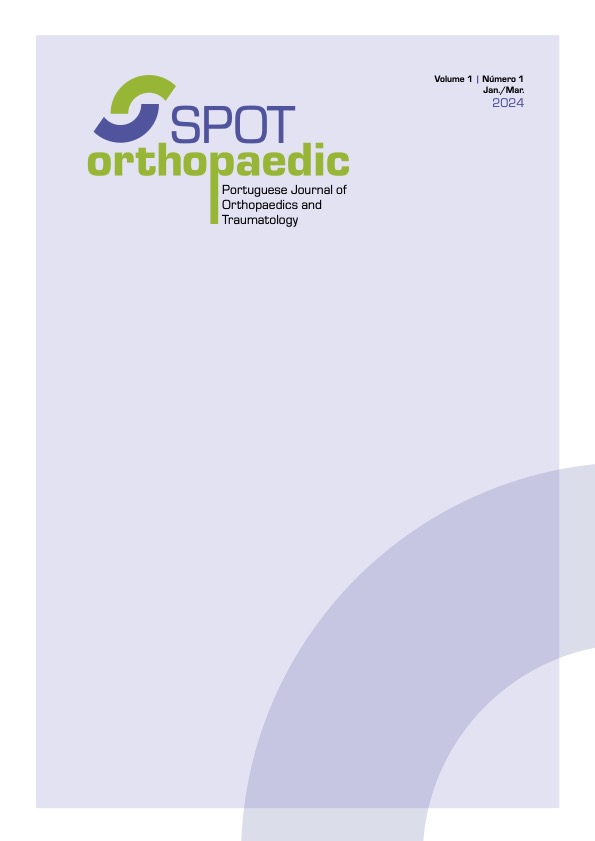Conflitos à Volta do Ombro e a Importância dos Equilíbrios Dinâmicos: Conceitos Atuais
DOI:
https://doi.org/10.82189/spot.33Palavras-chave:
Articulação do Ombro, Lesões da Coifa dos Rotadores, Lesões do Ombro, Ombro, Processo Coracóide/diagnóstico por imagemResumo
.
Downloads
Referências
Codman EA, Akerson IB. The pathology associated with rupture of the supraspinatus tendon. Ann Surg. 1931;93:348‐59.
Burkhart SS, Esch JC, Jolson RS. The rotator crescent and rotator cable: an anatomic description of the shoulder’s “suspension bridge”. Arthroscopy. 1993;9:611‐6.
Burkhart SS. Fluoroscopic comparison of kinematic patterns in massive rotator cuff tears. A suspension bridge model. Clin Orthop Relat Res. 1992:144‐52.
Moor BK, Bouaicha S, Rothenfluh DA, Sukthankar A, Gerber C. Is there an association between the individual anatomy of the scapula and the development of rotator cuff tears or osteoarthritis of the glenohumeral joint? A radiological study of the critical shoulder angle. Bone Joint J. 2013;95‐B:935‐41. doi: 10.1302/0301‐620X.95B7.31028.
Mendes J, Gutierres M. Critical Shoulder Angle: correlation with extension and retraction of supraspinatus tendon tears. [Tese Mestrado Integrado apresentado à Faculdade de Medicina, Universidade do Porto]. Porto: FMUP; 2017.
Tollemar VC, Wang J, Koh JL, Lee MJ, Shi LL. Coracoid morphology is not associated with subscapularis tears. J Shoulder Elbow Surg. 2020;29:1162‐7. doi: 10.1016/j.jse.2019.11.008.
Leite MJ, Sá MC, Lopes MJ, Matos RM, Sousa AN, Torres JM. Coracohumeral distance and coracoid overlap as predictors of subscapularis and long head of the biceps injuries. J Shoulder Elbow Surg. 2019;28:1723‐7. doi: 10.1016/j.jse.2019.01.012.
Leite MJ, Pinho AR, Sá MC, Silva MR, Sousa AN, Torres JM. Coracoid morphology and humeral version as risk factors for subscapularis tears. J Shoulder Elbow Surg. 2020;29:1804‐10. doi: 10.1016/j. jse.2020.01.074.
Faria A, Gutierres M. Subscapularis tears are associated with diminished coracohumeral distance: a systematic review and meta‐analysis study. [Tese Mestrado Integrado apresentado à Faculdade de Medicina, Universidade do Porto]. Porto: FMUP; 2020.
HeyworthBE,WilliamsRJ3rd.Internalimpingementoftheshoulder.AmJ Sports Med. 2009;37:1024‐37. doi: 10.1177/0363546508324966.
Carbone S, Postacchini R, Gumina S. Scapular dyskinesis and SICK syndrome in patients with a chronic type III acromioclavicular dislocation. Results of rehabilitation. Knee Surg Sports Traumatol Arthrosc. 2015;23:1473‐80. doi: 10.1007/s00167‐014‐2844‐5.
Kibler WB, Ludewig PM, McClure PW, Michener LA, Bak K, Sciascia AD. Clinical implications of scapular dyskinesis in shoulder injury: the 2013 consensus statement from the ‘Scapular Summit’. Br J Sports Med. 2013;47:877‐85. doi: 10.1136/bjsports‐2013‐092425.
Teixeira DC, Alves L, Gutierres M. The role of scapular dyskinesis on rotator cuff tears: a narrative review of the current knowledge. EFORT Open Rev. 2021;6:932‐40. doi: 10.1302/2058‐5241.6.210043.
Bowen JE, Malanga GA. Chapter 16: rotator cuff tendinopathy. In: Frontera WR, Silver JK, Rizzo Jr TD, editors. Essentials of Physical Medicine and Rehabilitation. 3rd ed. Philadelphia: Health Sciences; 2014. p. 80‐4.
Millett PJ, Wilcox RB 3rd, O’Holleran JD, Warner JJ. Rehabilitation of the rotator cuff: an evaluation‐based approach. J Am Acad Orthop Surg. 2006;14:599‐609. doi: 10.5435/00124635‐200610000‐00 002.
Downloads
Publicado
Edição
Secção
Licença
Direitos de Autor (c) 2024 Manuel Gutierres (Autor)

Este trabalho encontra-se publicado com a Licença Internacional Creative Commons Atribuição 4.0.






